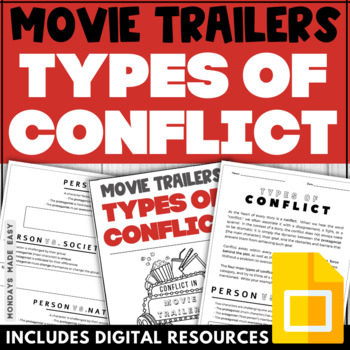Types of Conflict - Literary Conflict Examples - Activity for Any Movie Trailer
- PDF
- Google Apps™

What educators are saying
Description
Explore the four types of literary conflict using any movie trailer! This lesson differentiates between person vs. person, person vs. self, person vs. society, and person vs. nature. Students can use the graphic organizer provided to analyze the literary conflict in your students' favorite film trailers.
Included with this Types of Literary Conflict Lesson:
✏️ Types of Conflict Informational Handout - Digital & Print
- Differentiate between the four types of conflict: person vs. person, person vs. self, person vs. society, and person vs. nature
✏️ Identifying Conflict in Movie Trailers Graphic Organizer - Digital & Print
- Scaffold literary analysis of students’ favorite films
- Graphic organizer worksheet applicable to any movie trailer
✏️ Teacher Instructions for using this resource
How to use this Lesson and Graphic Organizer for Teaching Types of Conflict:
Are you looking for ways to incorporate students’ favorite movies into your English Language Arts curriculum? This activity will engage students in popular culture while exploring the four types of literary conflict: person vs. person, person vs. self, person vs. society, and person vs. nature.
You can begin this lesson with the Types of Conflict Informational Handout. This handout defines each of the types of conflict in literature using literary terms (protagonist, antagonist, symbolism). Students are prompted to consider an example for each type of literary conflict; they can think of a story, film, or even a real-life situation that demonstrates each type of conflict.
Once students have made a connection between their prior knowledge and each type of conflict, they are ready to start examining their favorite movie trailers. The informational handout explains that conflict is represented in essentially every narrative. Because of this, you can apply this activity to any movie trailer. This is because most movie trailers will allude to the literary conflict within the plotline of the film because conflict is also the "buy-in" for the audience.
The Identifying Conflict in Movie Trailers Graphic Organizer will prompt students to organize the information presented in the film trailer. This worksheet will scaffold questions that students can ask themselves to determine the type of literary conflict presented in a plotline of a story.
⭒ For classrooms utilizing Google Classroom® ⭒
To access the digital version of these worksheets, simply follow the instructions within the resource to copy the files directly to your Google Drive®.
❤️ See what others are saying! ❤️
Elizabeth W.
November 15, 2021
⭐⭐⭐⭐⭐ Extremely satisfied
My students liked this VERY MUCH!!! And I loved how straightforward and yet open-ended it was. A very flexible resource. Thank you. I am a big fan of your work!
Emma T.
November 14, 2020
⭐⭐⭐⭐⭐ Extremely satisfied
This was straightforward and easy to use. I (and my students) liked that each sheet wasn't overwhelming, and that they were able to use their own experience of film to identify the conflict types. Much appreciated.
germanyLCT T.
August 17, 2020
⭐⭐⭐⭐⭐ Extremely satisfied
Thank you so much for producing a quality resource that the students can use on reviewing movies. This product is well made and displays pride in the work you produce. Thank you for sharing!
✨ Kindly note that due to copyright restrictions, this resource is not editable. This is a common practice within the TPT marketplace in order to protect the clip artists and software providers that have authorized their intellectual property for the development of this resource.
You might also be interested in Mondays Made Easy's Digital Resources.
➖➖➖➖➖➖➖➖➖➖➖➖➖➖➖➖➖➖➖➖➖➖➖➖➖➖➖➖➖➖
⭐ Customer Tip! ⭐
Want FREE CREDIT to go towards purchases? Make sure to offer feedback for your downloads! Follow these instructions below:
- Go to your "My Purchases" page to find a "Provide Feedback" button next to each download.
- Follow this link to offer a quick rating and leave a short comment for the product. Each time you give feedback, TPT gives you feedback credits that you use to lower the cost of your future purchases!
- Your feedback is important to me as it helps me to continually improve my products and ensure they are meeting your needs!
Follow me! Be the first to know about product launches, sales, discounts, and free giveaways:
➾ The Blog
For questions, collaborations, or other concerns:
✉ Contact me: hello@mondaysmadeeasy.com
Access my Free Resource Library!
➖➖➖➖➖➖➖➖➖➖➖➖➖➖➖➖➖➖➖➖➖➖➖➖➖➖➖➖➖➖
Mondays Made Easy is committed to the continual improvement of resources to meet the current needs of teachers. This product was last updated on January 29, 2021.





